

النبات

مواضيع عامة في علم النبات

الجذور - السيقان - الأوراق

النباتات الوعائية واللاوعائية

البذور (مغطاة البذور - عاريات البذور)

الطحالب

النباتات الطبية


الحيوان

مواضيع عامة في علم الحيوان

علم التشريح

التنوع الإحيائي

البايلوجيا الخلوية


الأحياء المجهرية

البكتيريا

الفطريات

الطفيليات

الفايروسات


علم الأمراض

الاورام

الامراض الوراثية

الامراض المناعية

الامراض المدارية

اضطرابات الدورة الدموية

مواضيع عامة في علم الامراض

الحشرات


التقانة الإحيائية

مواضيع عامة في التقانة الإحيائية


التقنية الحيوية المكروبية

التقنية الحيوية والميكروبات

الفعاليات الحيوية

وراثة الاحياء المجهرية

تصنيف الاحياء المجهرية

الاحياء المجهرية في الطبيعة

أيض الاجهاد

التقنية الحيوية والبيئة

التقنية الحيوية والطب

التقنية الحيوية والزراعة

التقنية الحيوية والصناعة

التقنية الحيوية والطاقة

البحار والطحالب الصغيرة

عزل البروتين

هندسة الجينات


التقنية الحياتية النانوية

مفاهيم التقنية الحيوية النانوية

التراكيب النانوية والمجاهر المستخدمة في رؤيتها

تصنيع وتخليق المواد النانوية

تطبيقات التقنية النانوية والحيوية النانوية

الرقائق والمتحسسات الحيوية

المصفوفات المجهرية وحاسوب الدنا

اللقاحات

البيئة والتلوث


علم الأجنة

اعضاء التكاثر وتشكل الاعراس

الاخصاب

التشطر

العصيبة وتشكل الجسيدات

تشكل اللواحق الجنينية

تكون المعيدة وظهور الطبقات الجنينية

مقدمة لعلم الاجنة


الأحياء الجزيئي

مواضيع عامة في الاحياء الجزيئي


علم وظائف الأعضاء


الغدد

مواضيع عامة في الغدد

الغدد الصم و هرموناتها

الجسم تحت السريري

الغدة النخامية

الغدة الكظرية

الغدة التناسلية

الغدة الدرقية والجار الدرقية

الغدة البنكرياسية

الغدة الصنوبرية

مواضيع عامة في علم وظائف الاعضاء

الخلية الحيوانية

الجهاز العصبي

أعضاء الحس

الجهاز العضلي

السوائل الجسمية

الجهاز الدوري والليمف

الجهاز التنفسي

الجهاز الهضمي

الجهاز البولي


المضادات الميكروبية

مواضيع عامة في المضادات الميكروبية

مضادات البكتيريا

مضادات الفطريات

مضادات الطفيليات

مضادات الفايروسات

علم الخلية

الوراثة

الأحياء العامة

المناعة

التحليلات المرضية

الكيمياء الحيوية

مواضيع متنوعة أخرى

الانزيمات
The Genetic Variability of Bacteria
المؤلف:
Fritz H. Kayser
المصدر:
Medical Microbiology -2005
الجزء والصفحة:
2-3-2016
4176
The Genetic Variability of Bacteria
Changes in bacterial DNA are the result of spontaneous mutations in individual genes as well as recombination processes resulting in new genes or genetic combinations. Based on the molecular mechanisms involved, bacterial recombinations are classified as homologous, site-specific, and transpositional. The latter two in particular reflect the high level of mobility of many genes and have made essential contributions to the evolution of bacteria.
Although sexual heredity is unknown in bacteria, they do make use of the mechanisms of intercellular transfer of genomic material known as Para sexual processes. Transformation designates transfer of DNA that is essentially chemically pure from a donor into a receptor cell. In transduction, bacteriophages serve as the vehicles for DNA transport. Conjugation is the transfer of DNA by means of cell-to-cell contact. This process, made possible by conjugative plasmids and transposons, can be a high-frequency one and may even occur between partners of different species, genera, or families. The transfer primarily involves the conjugative elements themselves. Conjugative structures carrying resistance or virulence genes are of considerable medical significance.
The processes of restriction and modification are important factors limiting genetic exchange among different taxa. Restriction is based on the effects of restriction endonucleases capable of specific excision of foreign DNA sequences. These enzymes have become invaluable tools in the field of genetic engineering.
Molecular Mechanisms of Genetic Variability
Spontaneous Mutation
In the year 1943, Luria and Delbriick used the so-called fluctuation test to demonstrate that changes in the characteristics of bacterial populations were the results of rare, random mutations in the genes of individual cells, which then were selected. Such mutations may involve substitution of a single nucleotide, frame-shifts, deletions, inversions, or insertions. The frequency of mutations is expressed as the mutation rate, which is defined as the probability of mutation per gene per cell division. The rate varies depending on the gene involved and is approximately 10-6 to 10-10. Mutation rates may increase drastically due to mutagenic factors such as radioactivity, UV radiation, alkylating chemicals, etc.
Recombination
The term recombination designates processes that lead to the restructuring of DNA, formation of new genes or genetic combinations.
Homologous (generalized) recombination. A precise exchange of DNA be-tween corresponding sequences. Several enzymes contribute to the complex breakage and reunion process involved, the most important being the RecA enzyme and another the RecBC nuclease.
Site-specific recombination. Integration or excision of a sequence in or from target DNA. Only a single sequence of a few nucleotides of the integrated DNA needs to be homologous with the recombination site on the target DNA. The integration of bacteriophage genomes is an example of what this process facilitates Integration of several determinants of antibiotic resistance in one integron can also utilize this process (Fig. 3.19). Resistance integrons may be integrated in transposable DNA.
Transposition. The transposition process does not require the donor and target DNA to be homologous. DNA sequences can either be transposed to a different locus on the same molecule or to a different replicon. Just as in site- specific recombination, transposition has always played a major role in the evolution of multi-resistance plasmids (see Fig. 3.23).
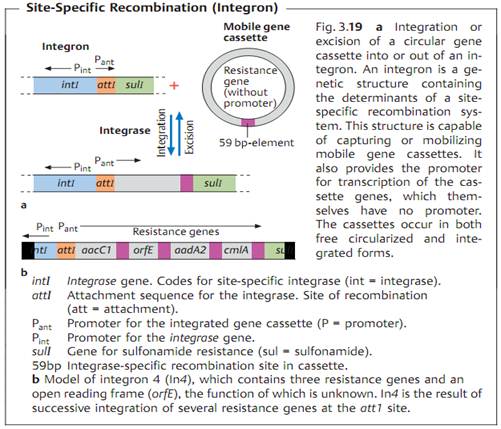
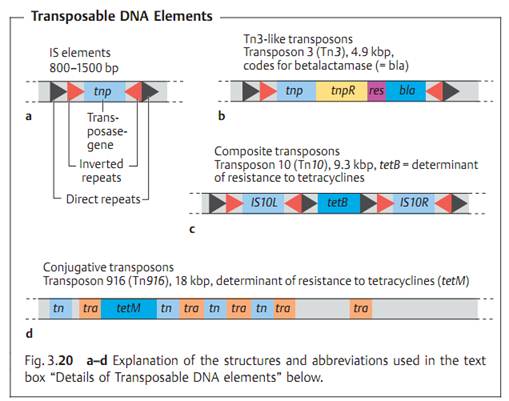
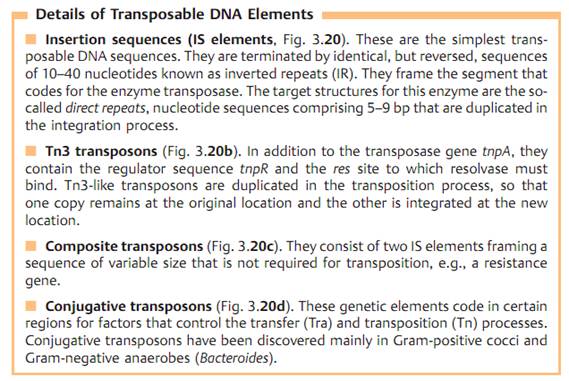
Intercellular Mechanisms of Genetic Variability
Although bacteria have no sexual heredity in the strict sense, they do have mechanisms that allow for intercellular DNA transfer. These mechanisms, which involve a unilateral transfer of genetic information from a donor cell to a receptor cell, are subsumed under the term Parasexuality.
Transformation
Transfer of “naked” DNA. In 1928, Griffith demonstrated that the ability to produce a certain type of capsule could be transferred between different pneumococci. Then Avery showed in 1944 that the transforming principle at work was DNA. This transformation process has been observed mainly in the genera Streptococcus, Neisseria, Helicobacter and Haemophilus.
Transduction
Transfer of DNA from a donor to a receptor with the help of transport bacteriophages (Fig. 3.21).
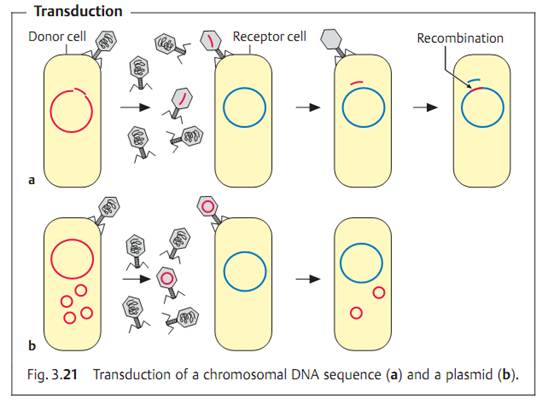
Bacteriophages are viruses that infect bacteria . During their replication process, DNA sequences from the host bacterial cell may replace all or part of the genome in the phage head. Such phage particles are then defective. They can still dock on receptor cells and inject their DNA, but the infected bacterial cell will then neither produce new phages nor be destroyed.
Conjugation
Conjugation is the transfer of DNA from a donor to a receptor in a conjugal process involving cell-to-cell contact. Conjugation is made possible by two genetic elements: the conjugative plasmids and the conjugative transposons.
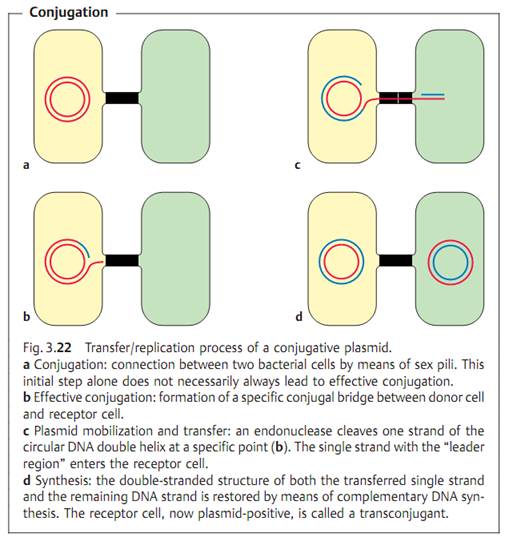
In the conjugation process, the conjugative elements themselves are what are primarily transferred. However, these elements can also mobilize chromosomal genes or otherwise nontransferable plasmids. Conjugation is seen frequently in Gram-negative rods (Enterobacteriaceae), in which the phenomenon has been most thoroughly researched, and enterococci.
The F-factor in Escherichia coli. This is the prototype of a conjugative plasmid. This factor contains the so-called tra (transfer) genes responsible both for
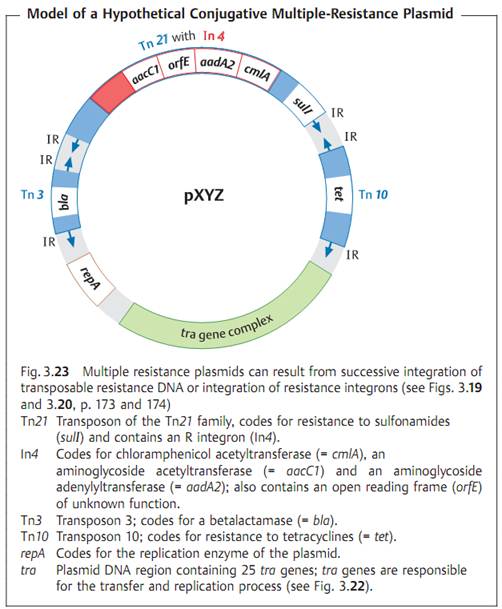
the formation of conjugal pili on the surface of F cells and for the transfer process. The transfer of the conjugative plasmid takes place as shown here in schematic steps (Fig. 3.22).
Occasional integration of the F factor into the chromosome gives it the conjugative properties of the F factor. Such an integration produces a sort of giant conjugative element, so that chromosomal genes can also be transferred by the same mechanism. Cells with an integrated F factor are therefore called Hfr (“high frequency of recombination”) cells.
Conjugative resistance and virulence plasmids. Conjugative plasmids that carry determinants coding for antibiotic resistance and/or virulence in addition to the tra genes and repA are of considerable medical importance. Three characteristics of conjugative plasmids promote a highly efficient horizontal spread of these determinant factors among different bacteria:
- High frequency of transfer. Due to the “transfer replication” mechanism, each receptor cell that has received a conjugative plasmid automatically be¬comes a donor cell. Each plasmid-positive cell is also capable of multiple plas¬mid transfers to receptor cells.
- Wide range of hosts. Many conjugative plasmids can be transferred between different taxonomic species, genera, or even families.
- Multiple determinants. Many conjugative plasmids carry several genes determining the phenotype of the carrier cell. The evolution of a hypothetical conjugative plasmid carrying several resistance determinants is shown schematically in Fig. 3.23.
Conjugative transposons. These are DNA elements that are usually integrated into the bacterial chromosome. They occur mainly in Gram-positive cocci, but have also been found in Gram-negative bacteria (Bacteroides). Conjugative transposons may carry determinants for antibiotic resistance and thus contribute to horizontal resistance transfer. In the transfer process, the transposon is first excised from the chromosome and circularized. Then a single strand of the double helix is cut and the linearized single strand—analogous to the F factor—is transferred into the receptor cell. Conjugative transposons are also capable of mobilizing non-conjugative plasmids.
Restriction, Modification, and Gene Cloning
The above descriptions of the mechanisms of genetic variability might make the impression that genes pass freely back and forth among the different bacterial species, rendering the species definitions irrelevant. This is not the case. A number of control mechanisms limit these genetic exchange processes. Among the most important are restriction and modification.
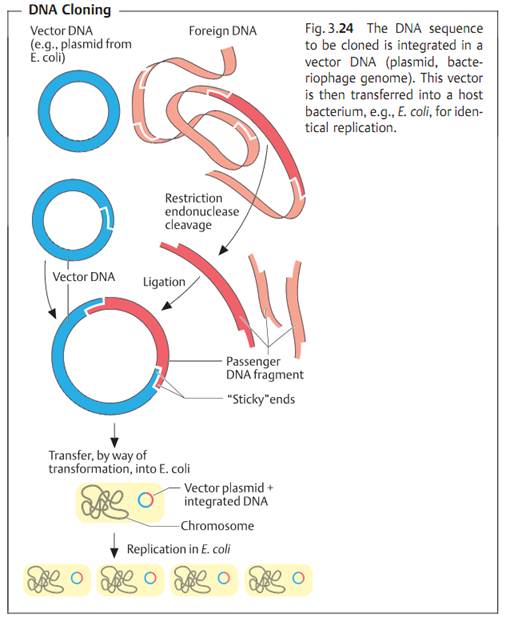
Restriction endonucleases can destroy foreign DNA that bears no “fingerprint" (modification) signifying “self.” These modifications take the form of methy- lation of the DNA bases by modification enzymes.
Bacterial restriction endonucleases are invaluable tools in modern gene cloning techniques. The process is termed gene “cloning” because it involves replication of DNA that has been manipulated in vitro in a suitable host cell so as to produce identical copies of this DNA: molecular clones or gene clones.
The technique simplifies the replication of DNA, making experimental manipulations easier. On the other hand, the bacteria can also be used to synthesize gene products of the foreign genes. Such foreign proteins are called recombinant proteins. Bacterial plasmids often function in the role of vectors into which the sequences to be cloned are inserted. Fig. 3.24 illustrates the principle of gene cloning in simplified form.
Table 3.3 lists the most important terms used in the field of bacterial genetics.
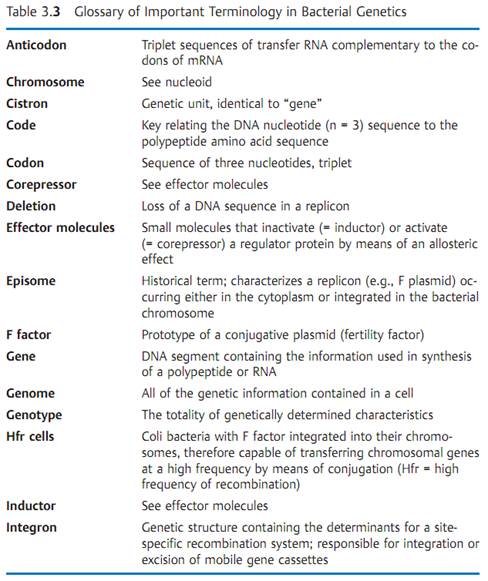
Table 3.3 Continued: Glossary of Important Terminology...
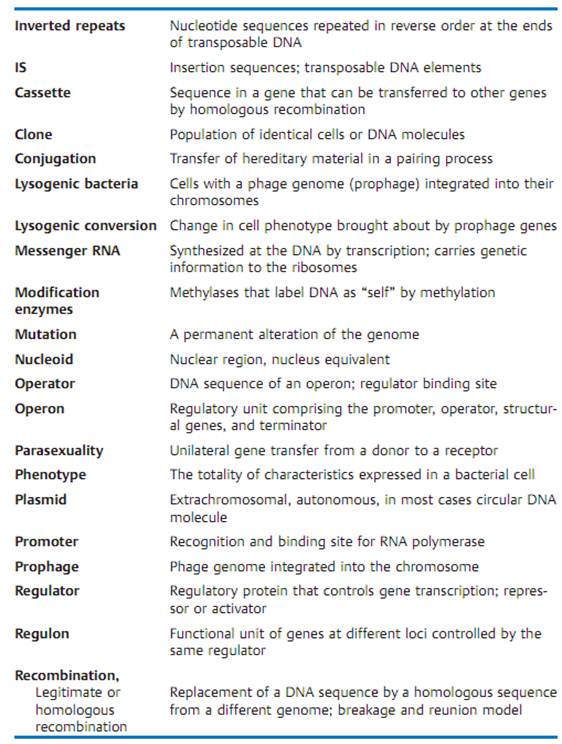
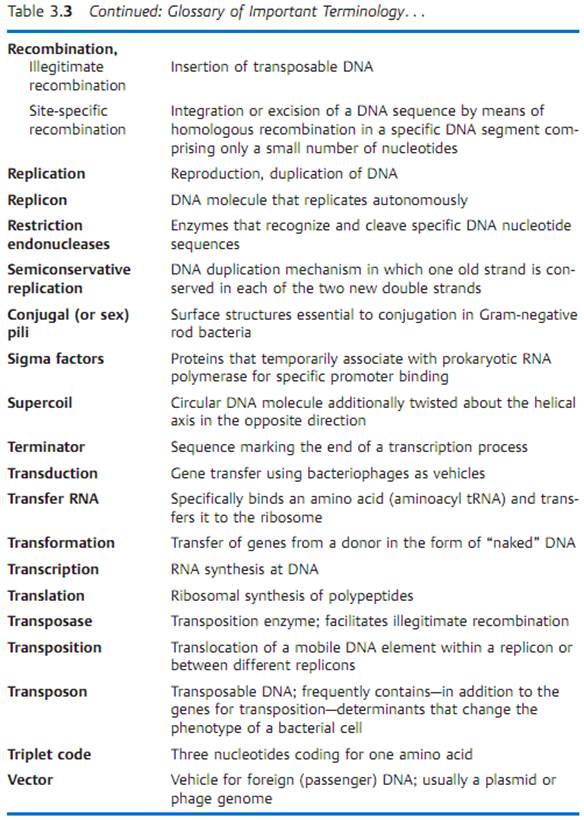
 الاكثر قراءة في البكتيريا
الاكثر قراءة في البكتيريا
 اخر الاخبار
اخر الاخبار
اخبار العتبة العباسية المقدسة

الآخبار الصحية















 قسم الشؤون الفكرية يصدر كتاباً يوثق تاريخ السدانة في العتبة العباسية المقدسة
قسم الشؤون الفكرية يصدر كتاباً يوثق تاريخ السدانة في العتبة العباسية المقدسة "المهمة".. إصدار قصصي يوثّق القصص الفائزة في مسابقة فتوى الدفاع المقدسة للقصة القصيرة
"المهمة".. إصدار قصصي يوثّق القصص الفائزة في مسابقة فتوى الدفاع المقدسة للقصة القصيرة (نوافذ).. إصدار أدبي يوثق القصص الفائزة في مسابقة الإمام العسكري (عليه السلام)
(نوافذ).. إصدار أدبي يوثق القصص الفائزة في مسابقة الإمام العسكري (عليه السلام)


















